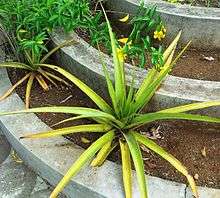Aloe purpurea
| Aloe purpurea | |
|---|---|
| | |
| Aloe purpurea in cultivation. | |
| Scientific classification | |
| Kingdom: | Plantae |
| Clade: | Angiosperms |
| Clade: | Monocots |
| Order: | Asparagales |
| Family: | Asphodelaceae |
| Subfamily: | Asphodeloideae |
| Genus: | Aloe |
| Species: | A. purpurea |
| Binomial name | |
| Aloe purpurea Lamark. | |
Aloe purpurea (previously Lomatophyllum purpureum/borbonicum/aloiflorum. Locally known as "Mazambron") is a species of Aloe endemic to the island of Mauritius, in the Indian Ocean.
It was previously widespread in Mauritius, where it occurred on dry rocky slopes and outcrops, the highland plateaus, and the forests of the west.
It is part of a group of aloes which bear fleshy berries, and were therefore classed as a separate group, "Lomatophyllum". It is also one of only two Aloe species which naturally occur on Mauritius - both endemic and occurring nowhere else.[1]
Description


This species grows an erect stem, and can reach a height of 3 meters (unlike its closest relative Aloe tormentorii which is usually acaulescent or decumbent). The stem is topped by a dense rosette of up to 20 leaves. Its long, lanceolate leaves are usually a dark green or slightly reddish, with red margins. Its species name "purpurea" means "purple".
Its flowers grow on cylindrical racemes; the green-yellow buds of the flowers become yellow-pink when open. It is especially closely related to Aloe macra of Reunion island, and the two species look very similar. However Aloe purpurea can be distinguished by its longer, more dull-coloured, flowers with longer pedicels.
Distribution
This species is endangered, and occurs naturally only on Mauritius and its surrounding rocky islets. Here it is found in dry and palm-rich forests, and on rocky outcrops. It was previously widespread across Mauritius, but is now extremely rare. It is beginning to be propagated as an ornamental and landscaping plant in Mauritius; a locally indigenous alternative to Aloe vera.
In Mauritius it was traditionally used as a medicine for muscle-pain and its sap was applied to mothers' nipples to wean infants.[2][3]
References
| Wikimedia Commons has media related to Aloe purpurea. |
